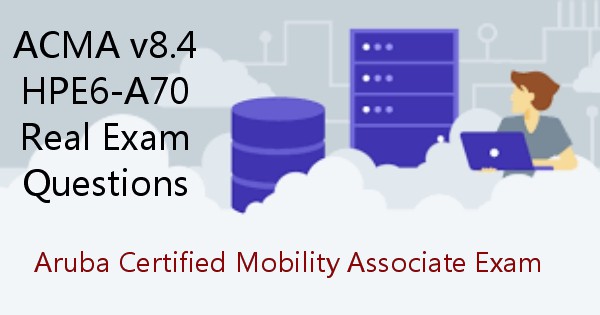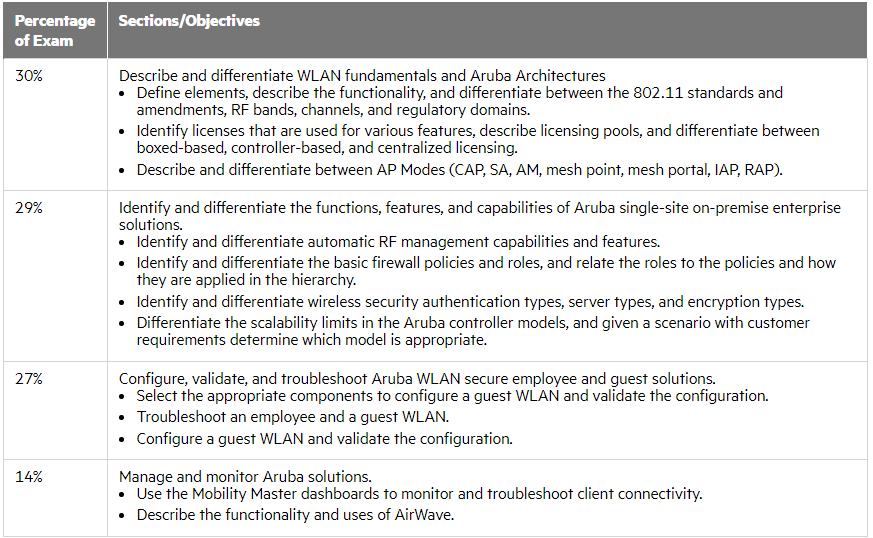ACMA v8.4 HPE6-A70 Real Exam Questions - Aruba Certified Mobility Associate Exam
HPE6-A70 Aruba Certified Mobility Associate Exam is for ACMA v8.4 Certification, we have candidates passed this ACMA HPE6-A70 exam with a score of 96% on Mar.06.2020,so you can feel easy to study our PassQuestion HPE6-A70 Real Exam Questions for your preparation. All these 60 questions in HPE6-A70 Real Exam Questions are collected from real test, which can ensure you pass your ACMA v8.4 Certification HPE6-A70 exam successfully.

HPE6-A70 Aruba Certified Mobility Associate Exam Description
The Aruba Certified Mobility Associate Exam tests your knowledge and skills to deploy AOS 8 single-site, on premise, geographically simple enterprise WLANs. Typical candidates for this certification are networking IT professionals who deploy small-to-medium scale network solutions based on Aruba products and technologies.

HPE6-A70 Exam Objectives Tested for ACMA v8.4 Certification

View HPE6-A70 Sample Questions Collected From PassQuestion HPE6-A70 Real Exam Questions
1.A network administrator creates the role employees and adds this rule to it:
user any any permit
The first several wireless clients assigned to the employees role are assigned IP addresses in the 10.10.10.0/24 subnet. Several other wireless clients with the employees role are then assigned IP addresses in the 10.10.20.0/24.
When the Aruba firewall matches traffic from these clients to the user any any permit rule, what does it do?
A. It permits traffic from wireless clients in both the 10.10.10.0/24 and 10.10.20.0/24 subnet as long as the packet has a source IP.
B. It permits the traffic from wireless clients in the 10.10.20.0/24 subnet, but drops the traffic from wireless clients in the 10.10.10.0/24 subnet.
C. It drops traffic from wireless clients in both the 10.10.10.0/24 and 10.10.20.0/24 subnet.
D. It permits the traffic from wireless clients in the 10.10.10.0/24 subnet, but drops the traffic from wireless clients in the 10.10.20.0/24 subnet.
Answer: A
2.A company has many 7220 controllers in its Aruba wireless architecture. A network administrator wants to use the Traffic Analysis dashboard in order to monitor which type of applications are being used by wireless users.
What is required for this implementation?
A. AirMatch and ClientMatch must be enabled.
B. The solution must have active PEFNG licenses.
C. WLANs must use the decrypt-tunnel forwarding option.
D. Firewall policies must include application filtering rules.
Answer: B
3.A network administrator configures an Aruba Mobility Master (MM)-based solution to provide wireless access to employees.
The solution must meet these criteria:
- Authenticate users to a network RADIUS server
- Enforce different Aruba firewall rules based on the user department
How can the administrator meet these criteria in the simplest way?
A. Create a different WLAN and SSID for each department. Apply different firewall policies to each WLAN.
B. Have the RADIUS server send different roles for users in different departments. Apply role-based firewall policies.
C. Create multiple zones on the MM. Assign different departments are sets of firewall policies to different zones.
D. Have the RADIUS server assign users in different departments to different VLANs. Apply firewall policies based on IP ranges.
Answer: B
4.Users to which this policy apply are unable to receive IP addresses with DHCP.

How should the administrator fix the issue?
A. Move the user any svc-dhcp permitrule to the bottom of the list.
B. Remove the deny rule from the policy.
C. Use the correct service alias in the user any svc-dhcp permitrule.
D. Change user to any in the user any svc-dhcp permitrule.
Answer: C
5.An Aruba solution runs ArubaOS 8 and uses a mobility master architecture.
Which feature can network administrators use to balance wireless across APs on different channels?
A. AppRF
B. ARM
C. Client Match
D. AirMatch
Answer: C
6.What is the difference between how a network administrator can monitor clients in the Mobility (MM) interface and in the AirWave Management Platform?
A. AirWave shows trends for the past several minutes, while MM shows longer trends.
B. AirWave combines information from more sources, such as RADIUS authenticating servers and APs.
C. AirWave shows the current signal level for the client connection, while MM does not show RF statistics.
D. MM shows user and role information associated with clients, while AirWave does not.
Answer: B
Related Exam
- TOP 50 Exam Questions
-
Exam
All copyrights reserved 2025 PassQuestion NETWORK CO.,LIMITED. All Rights Reserved.

